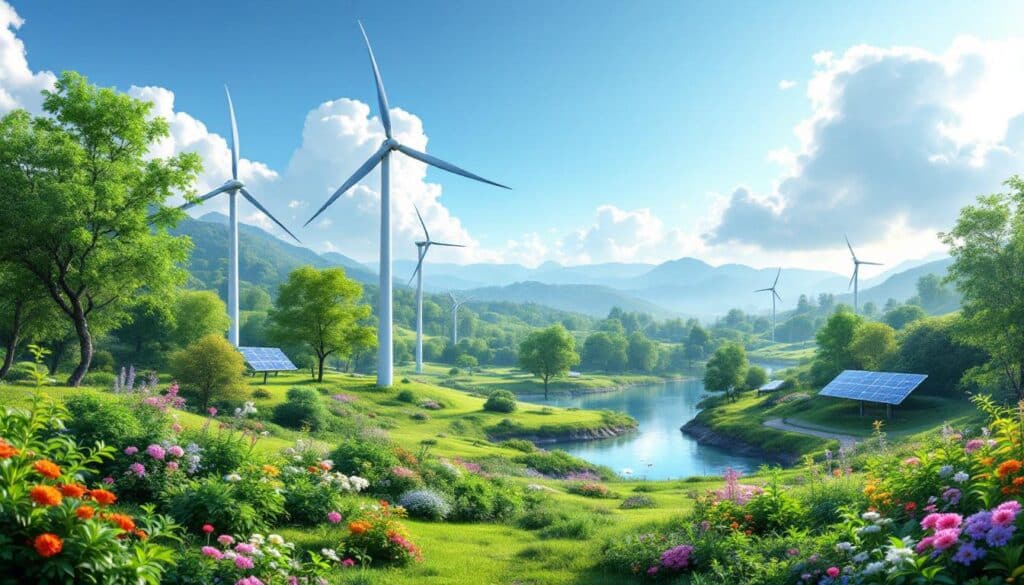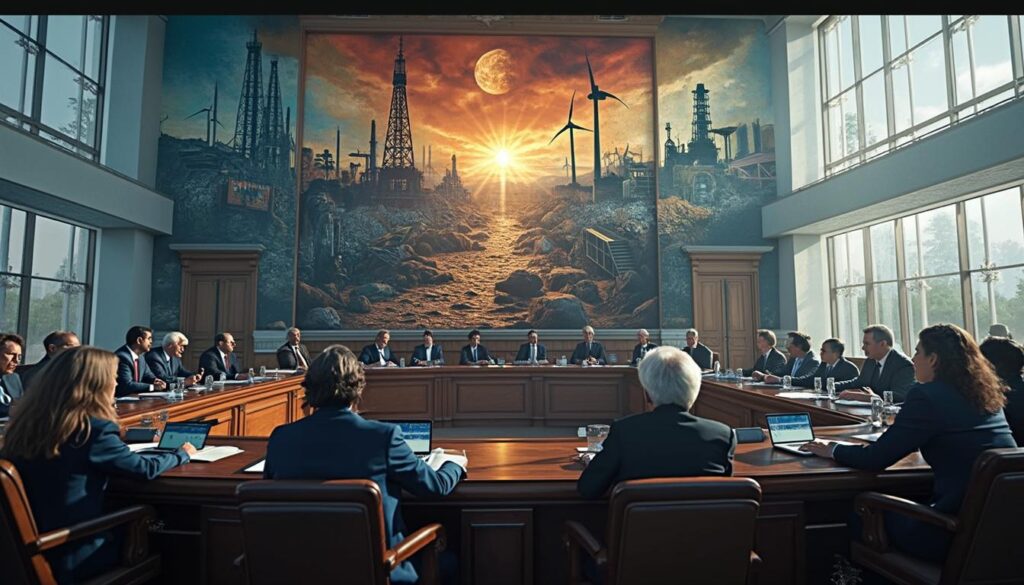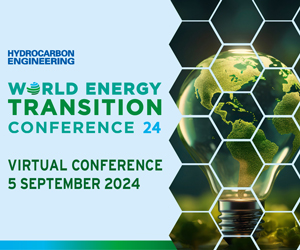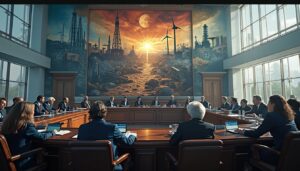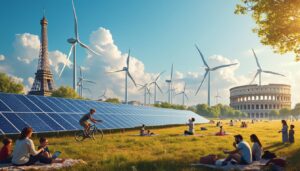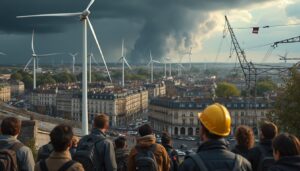A revealing report from a group dedicated to clean energy highlights that the massive adoption of solar and wind could sow chaos in New York’s electric grid. The ambitions of the State’s green energy law pose significant challenges in terms of cost and reliability. At first glance, this promising transition could turn out to be perilous.
It appears that the timeline set to eliminate fossil fuels is not only unrealistic but also potentially dangerous. According to the report from the New York Affordable Clean Power Alliance, an energy generation shortfall could hit the New York City area as early as 2033, due to rising peak demand and the planned withdrawal of flexible production capacity.
The authors of the report emphasize the major obstacles posed by ambitious renewable goals, the gradual phase-out of flexible fossil fuel plants, the continually increasing electric load, and extreme weather conditions. The intermittent nature of solar and wind complicates real-time management of the balance between supply and demand.
The Climate Leadership and Community Protection Act of 2019, enacted under Andrew Cuomo’s governance, mandates a drastic 40% reduction in greenhouse gas emissions by 2030, with the ultimate goal of achieving 100% carbon-free electricity by 2040. However, various issues such as supply chain problems driven by inflation, rising material and labor costs, and extended construction timelines are significantly slowing the ramp-up of renewable infrastructure.
Furthermore, rising interest rates have significantly increased borrowing costs for developers, hindering investments in new projects. These financial pressures affect all categories of developers and lead to rising costs for utilities, especially if they are building large-scale renewables.
Adding to these challenges is the exorbitant cost of interconnecting solar and wind projects to the grid, which has doubled between 2017 and 2023. One of the main obstacles identified is the transmission bottleneck between the north regions rich in renewables and the southern consumption centers. Inadequate transmission limits the flow of electricity between regions and increases the development costs of renewable projects.
Faced with these obstacles, many private developers have had to abandon their projects due to unanticipated and excessive final cost estimates, making these projects unviable. Community opposition has also played a significant role in slowing, altering, or canceling major solar and wind projects across the state.
Despite these challenges, Governor Kathy Hochul reaffirms her commitment to the clean energy agenda, while emphasizing reliability and cost control for consumers. She promises to use all tools at her disposal to maintain a balance between energy transition and grid stability.
A recent report from the New York Affordable Clean Power Alliance has highlighted major concerns regarding the state’s ambitious transition to renewable energies. While the goal of drastically reducing greenhouse gas emissions and achieving zero-carbon electricity by 2040 is commendable, this change could pose significant challenges for New York’s electric grid.
Why is New York’s timeline problematic for energy reliability?
The report notes that the timeline set by New York for phasing out fossil fuels is both unrealistic and potentially dangerous. In particular, the New York City area could face an energy generation shortfall starting in 2033. This shortfall is due to the increase in peak demand and the planned withdrawal of fossil fuel combustion plants, which currently provide a dispatchable energy source, meaning available on demand.
The massive shift to solar and wind energies presents challenges related to their intermittent nature. Unlike fossil fuel plants, renewable energies depend on weather conditions, making real-time balancing of supply and demand more complex. This complexity could compromise the reliability of the electric grid, especially during peak demand or extreme weather conditions.
What obstacles hinder the scaling up of renewables in New York?
Several factors hinder the development of renewable energies in New York. Among them are supply chain problems exacerbated by inflation, rising material and labor costs, as well as prolonged construction timelines for solar and wind infrastructures. Furthermore, high interest rates have increased borrowing costs for developers, thereby slowing investment in new projects.
Another significant obstacle is the rising cost of connecting solar and wind projects to the electric grid. Interconnection costs have doubled between 2017 and 2023, making these projects less economically viable. According to the report, “the transmission bottleneck between the state’s renewable-rich regions and the densely populated load centers in the south of the state” significantly limits the flow of electricity, increasing development costs.
How does the community react to renewable energy projects?
The community reaction also plays a crucial role in the success of renewable energy projects. The report indicates that community opposition has delayed, modified, or canceled several major projects. For instance, the Lighthouse Wind project on Lake Ontario, initially planned to install 200 megawatts of turbines, was canceled after eight years of local opposition.
Similarly, the Hecate Energy Solar project in Copake, New York, had to cut its installation footprint by more than half in response to residents’ complaints, dropping from 500 to 215 acres. Another project, the lithium battery Union Energy Center in Mahopac, was suspended for six months due to community opposition. These examples illustrate how essential local acceptance is for the success of renewable energy initiatives.
What are the economic impacts of the transition to renewables?
The rapid transition to renewable energies also brings significant economic implications. The report highlights that cost pressures affect all types of developers and could also increase utility costs if large-scale renewable construction were permitted. As a result, utility giants like Con Edison have recently proposed double-digit rate hikes for gas and energy bills, partly due to compliance costs with environmental mandates.
These cost increases may have social repercussions by making energy less affordable for consumers. Furthermore, high development costs, especially those related to interconnection and project delays, decrease the profitability of investments in renewable energies. This could further hinder the adoption of these essential technologies to combat climate change.
What are the technical challenges of integrating renewables?
Integrating solar and wind energies into the electric grid presents complex technical challenges. As mentioned in the report, unlike fossil fuel plants which offer dispatchable generation available at all times, renewables heavily depend on weather conditions. This dependence complicates real-time balancing of supply and demand, increasing the risk of outages or grid instability.
To address these challenges, solutions like battery energy storage and improvements in transmission infrastructure are necessary. However, these solutions require heavy investments and ongoing technological innovations. Without these improvements, New York’s electric grid may not be able to support the growing load from renewable energies, thus compromising the state’s reliability and energy security.
What are the political and legislative perspectives?
The Climate Leadership and Community Protection Act of New York in 2019 sets ambitious goals for reducing greenhouse gas emissions and promoting renewable energies. However, these objectives face growing resistance at both the political and community levels. Politicians like Governor Kathy Hochul defend the energy transition by highlighting the progress made, such as the fact that 50% of the state’s electricity already comes from zero-emission sources.
However, there is increasing pressure from both Democrats and Republicans to slow down certain initiatives, such as the shift from gasoline cars to electric vehicles and the ban on gas stoves in new housing. These political adjustments reflect the complex challenges of reconciling environmental goals with energy reliability and economic viability.
What lessons can be learned from New York’s experience?
New York’s experience offers several valuable lessons for other regions considering a similar transition to renewable energies. First, it is crucial to balance climate ambitions with the reality of existing infrastructures and grid capacities. Second, community engagement and local acceptance are essential for the success of renewable energy projects.
Moreover, rigorous planning and investments in transmission and energy storage infrastructure are essential to ensure grid stability. Finally, a flexible and adaptive approach, taking into account feedback from stakeholders and technological developments, can help overcome the economic and technical challenges inherent in the energy transition.
How can other states avoid the pitfalls of New York?
Other states can take advantage of the lessons from New York by adopting a more balanced and integrated approach to energy transition. This includes diversifying renewable energy sources, investing in advanced storage technologies, and strengthening transmission infrastructures. Additionally, it is essential to promote dialogue and collaboration with local communities to minimize opposition and ensure a smooth adoption of the projects.
Initiatives similar to community solar projects can facilitate access to renewable energies while addressing local concerns. Furthermore, proactive cost management and anticipation of economic challenges can help maintain the long-term viability of renewable projects.
Ultimately, the key lies in strategic planning, continuous innovation, and close cooperation between the public and private sectors to ensure a successful and sustainable energy transition.
To learn more about the challenges and solutions related to renewable energies, please refer to the resources available on GreenJustNow.
Also discover the hidden secrets of renewable energies and the hidden impacts of the ecological transition by visiting our site.
For international perspectives, explore how the solar boom in China is redefining the global energy landscape.
Finally, learn how the rise of calls to ban renewable energy in certain states illustrates the political and social challenges of the energy transition.
Articles similaires
Thank you!
We will contact you soon.


